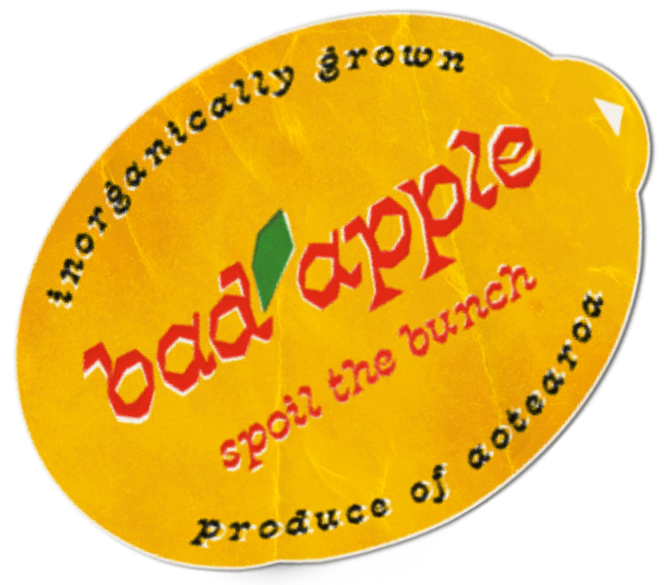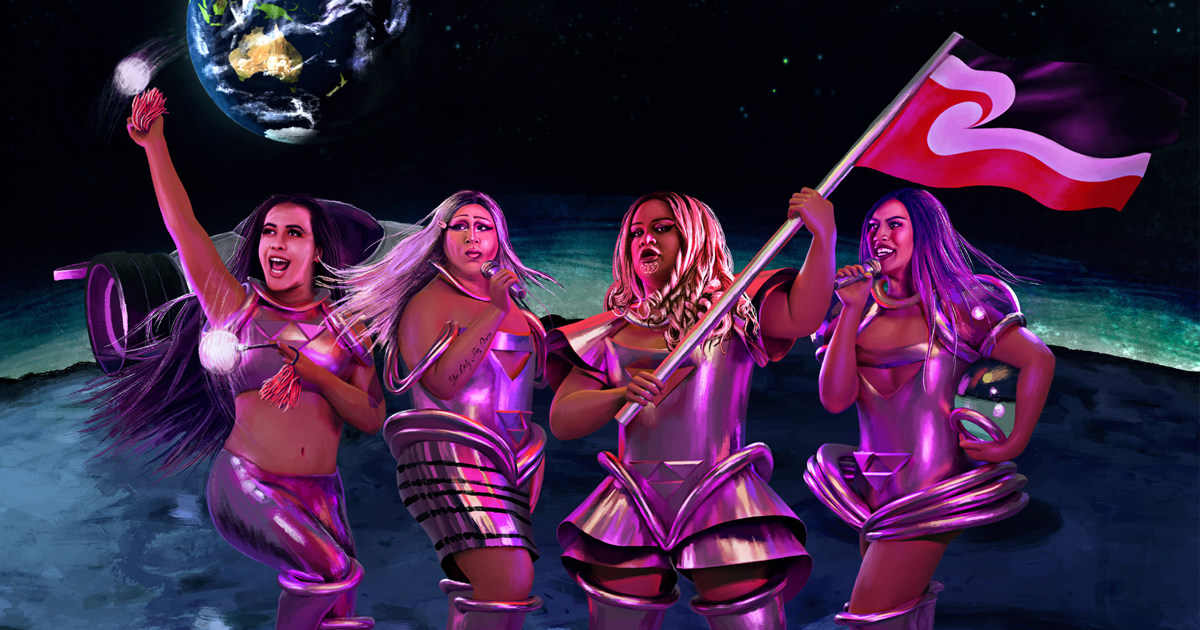In the iconic central Auckland black box theatre, The Basement, the air smelled faintly of perfume and alcohol. With everyone filling in, the banter grew; mumblings of the local POC queer community either exchanging hellos or introducing themselves brought energy and vibes into the space before the show had even begun.
Sitting in the front row for The Tiwhas: A Matariki Spectacular, although I was alone, the hum of people conversing around me made me feel like I’d brought my own company. The stage was illuminated in a soft pink and purple light, the rainbow tinsel backdrop hung from a wooden cutout of a wharenui. I counted 14 stars dotted along the roof and sides. The 15th star crowned in the middle at the very top in place of a koruru (where the different sides of the roofs would’ve met), was a reinforcement that Matariki itself are the ancestors in this space. Looking at it from purely an aesthetic perspective, the koruru had this origami-like feel, giving off a set design that was intricate, patterned and crafted with care. Placed just under the main star was the word ‘TIWHAS!’ in a thick bold font with korus adorned around it. A black and white chequered mat was placed just in front of the whare, a rough marking of the stage’s parameters, with all of the different aspects of the stage and set design coming together to serve a very retro feel and 80s-core.
Stray beams of light would catch on the tinsel and reflect along the floor, dancing. It was as if this itself was foreshadowing the brilliant show we were about to witness. Needless to say, the set-up and design of the stage was well-planned and captivating.
The Tiwhas’s opening song was nothing short of extraordinary. The audience was introduced to all four drag queens taking part in the storytelling: Slay West, Pania, Dame Jthan and Huh?Mama!.
We were also introduced to the trio of musicians to the side and the backstage support. I liked the added touch that Matariki wasn’t just the drag queens. Songs varied in hits from the 80s to the early 2000s and many were in te reo Māori. The Tiwhas encouraged us to sing where we could and there was a continuous wave of cheering and cheehoo-ing from us. Additionally, there were around five costume changes? To be honest, I lost count after four.
I absolutely loved that the dress changes weren’t just limited to our Tiwhas, but also the supporting cast to the sides. God, you could tell every single outfit was carefully considered and planned. The sequins, the glitter, everything.
Towards the end of the night, Slay West spoke on the importance of Pōhutukawa and its purpose—honouring those who have passed on. Earlier in the night, squares of paper with pens went around, ourselves writing down those who we would like to acknowledge while the show progressed into a slower, soft space. The waiata Māori gave me goosebumps and I had to remember to breathe. I teared up, dabbing away at the overwhelm of my own feelings.
Once the show was concluded, people slowly began to get up. Many lingered in their seats, processing the art we were lucky to witness and share space with.
“The Tiwhas: A Matariki Spectacular was truly fabulous and challenging in all senses of the word. You can see the hours of hard work put into every little thing that made up the performance.”
While walking out of the venue, there was a loud exclamation from someone saying “My cheeks hurt from smiling the whole time!” To put it simply, it was breathtaking. The choreography, the set, the singing, the performing, the makeup, the clothes, the lighting. It was nothing short of phenomenal. The Tiwhas: A Matariki Spectacular was truly fabulous and challenging in all senses of the word. You can see the hours of hard work put into every little thing that made up the performance.
Being in a space that uplifts queer Indigenous stories makes me surge with pride and hope. I am not Māori, however, I’m a queer Tongan who often doesn’t feel seen with many Pākehā-focused and produced queer media. I am definitely the type of person to go to a drag show and count how many palagi to Māori or Pasifika are in the crowd.
And for this reason, I have never, in 18 years of my life, felt more proud to be Pasifika and queer. The seamlessness of being able to exist in my intersectional identities, with so much space being held surprised me in the best way possible. Being acknowledged for Pacific ways of being, the brown humour, the queer humour!
Heading into the night, I felt like a weight on my shoulders had been removed. I was excited to go in and watch a te ao Māori drag show but left with a newfound realisation—that I am allowed to take up space in areas that I had previously allocated for palagi queer people, that I am even allowed to cheer, cry and laugh in those spaces.
I’m excited to see more pūrākau put into performances like this. Malo ‘aupito Tiwhas, your mahi to intertwine Indigenous stories and queer storytelling was equally thought-provoking and dazzling.



